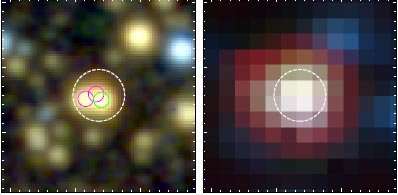Unraveling the stellar content of young clusters

About twenty-five percent of young stars in our galaxy form in clustered environments, and stars in a cluster are often close enough to each other to affect the way they accrete gas and grow. Astronomers trying to understand the details of star formation, for example the relative abundance of massive stars to low mass ones, must take such complicated clustering effects into account. Measuring the actual demographics of a cluster is not easy either.
Young stars are embedded within obscuring clouds of natal material. Infrared radiation can escape, however, and astronomers probe these regions at infrared wavelengths using the shape of the spectral energy distribution (the SED—the relative amounts of flux emitted at different wavelengths) to diagnose the nature of the young star: its mass, age, accretion activity, developing disk, and similar properties. One major complication is that the various telescopes and instruments used to measure an SED have large and different-sized beams that encompass multiple objects in a cluster. As a result, each point in an SED is a confused blend of emission from all the constituent stars, with the longest wavelength datapoints (from the largest beams) covering a spatial region perhaps ten times larger than the shortest wavelength points.
CfA astronomers Rafael Martinez-Galarz and Howard Smith and their two colleagues have developed a new statistical analysis technique to address the problem of confused SEDs in clustered environments. Using the highest spatial resolution images for each region, the team identifies the distinguishable stars (at least this many are in the cluster) and their emission at those wavelengths. They combine a Bayesian statistical approach with a large grid of modeled young stellar SEDs to determine the most probable continuation of each individual SED into the blended, longer-wavelength bands and thus leads to the determination of the most likely value of each star's mass, age, and environmental parameters. The resultant summed SED is not unique but is the most likely solution.
The astronomers apply their method to seventy young, low mass stellar clusters observed by the Spitzer Space Telescope's Infrared Array Camera, and derive their physical properties. Their results are in excellent agreement with general expectations for the distribution of stellar masses. They also find several unexpected preliminary results, including a relationship between the total mass of the cluster and the mass of its largest member. The team plans to extend the wavelength ranges included in their SED analysis and to increase the number of clusters analyzed.
More information: Unraveling the Spectral Energy Distributions of Clustered YSOs. arXiv:1803.10779 [astro-ph.SR] arxiv.org/abs/1803.10779
Provided by Harvard-Smithsonian Center for Astrophysics




















